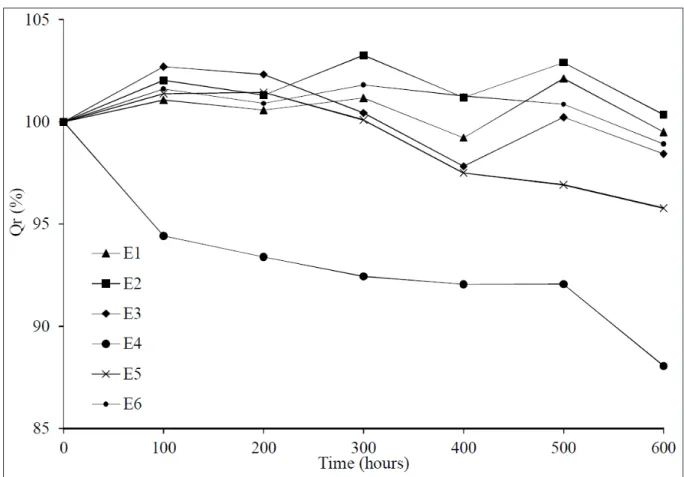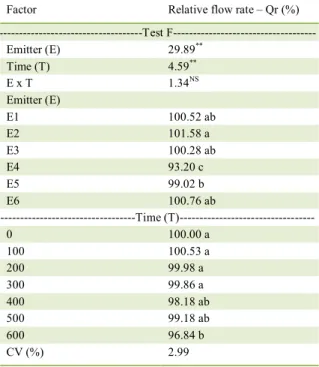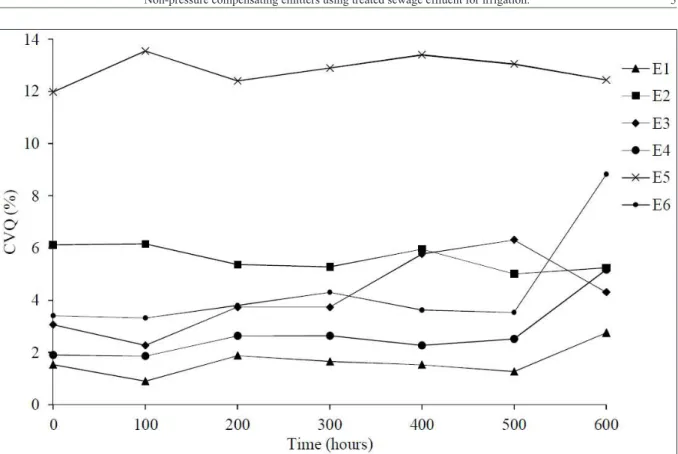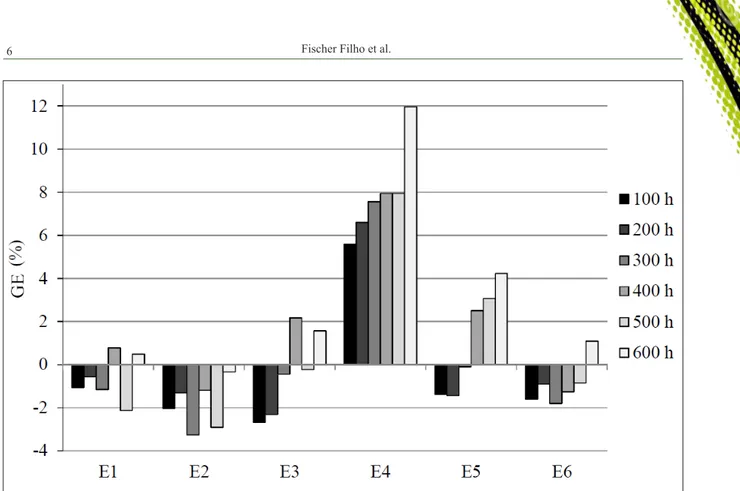Non-pressure compensating emitters using treated sewage effluent for irrigation
Gotejadores não autocompensantes usando efluente de esgoto tratado para irrigação
João Alberto Fischer Filho1* Alexandre Barcellos Dalri1 Miquéias Gomes dos Santos1
José Renato Zanini1 Rogério Teixeira de Faria1
ISSNe 1678-4596
INTRODUCTION
The consumption of water in agriculture in Brazil is approximately 70% of total (ANA, 2015).
This significant demand, coupled with the scarcity
of water resources in Brazil’s populous regions and the need for alternative sources of plant nutrients, indicates that agriculture should be given priority in
the reuse of treated sewage effluent (TSE).
Instead of contaminating surface water
and groundwater with nutrients in sewage effluent,
its use as irrigation water can meet the water and nutrient requirements of crops. Drip irrigation is used
for applying TSE and has advantages such as saving water, high efficiency and low contamination of the
agricultural product (DAZHUANG et al., 2009), and
it is characterized by low flow rate, with minimal
environmental, health and economic impact.
The presence of highly variable amounts of microorganisms in wastewater, which can agglomerate with mineral or organic particles in suspension and chemicals in the water, such as iron and sodium, can cause obstruction of drippers. Clogging of drippers is a serious problem associated with drip irrigation, compromising the uniformity of water application (NAKAYAMA & BUCKS,
1Departamento de Engenharia Rural, Faculdade de Ciências Agrárias e Veterinárias, Universidade Estadual Paulista (UNESP), Via de Acesso Prof. Paulo Donato Castellane, s/n, 14884-900, Jaboticabal, SP, Brasil. E-mail: joaofischer16@gmail.com. *Corresponding author.
ABSTRACT: This study aimed to evaluate the obstruction of non-pressure compensating emitters using treated sewage effluent (TSE) for
irrigation. A drip irrigation system with six models of emitters (encoded) was installed in level field conditions. TSE coming from a sewage treatment station was used as irrigation water after being filtered through a disc filter (120 mesh). Seven flow rate evaluations of drippers operating at 100kPa were performed (0, 100, 200, 300, 400, 500 and 600h of operation). The experimental design was randomized in a 6×7 factorial arrangement (6 models and 7 times), with four repetitions, and Tukey’s test was used to compare means. Relative flow rate (Qr), the flow rate coefficient of variation (CVQ) and degree of clogging (GE) were determined. There was a reduction in flow rate in five dripper models, which are susceptible to clogging. The model with rated flow stood out against the others, showing a Qr of 100.52%, CVQ of 2.76% and GE of 0.49%. The use of TSE changed the Qr of the drippers after 600h of operation.
Key words: wastewater, trickle irrigation, clogging, water saving.
RESUMO: Objetivou-se avaliar a obstrução de gotejadores não autocompensantes utilizando efluente de esgoto tratado (EET) para
irrigação. Um sistema de irrigação por gotejamento com seis modelos de gotejadores (codificados) foi instalado em nível e em condições de campo. Como água de irrigação foi utilizado EET, originado de estação de tratamento de esgoto, filtrado por um filtro de disco (120 mesh). Foram realizadas sete avaliações da vazão dos emissores (0, 100, 200, 300, 400, 500 e 600h de funcionamento), operando a 100kPa. O experimento foi montado em delineamento casualizado, com arranjo fatorial 6x7 (6 modelos e 7 tempos), com 4 repetições e teste de Tukey para comparação das médias. Foram determinados a vazão relativa (Qr), o coeficiente de variação de vazão (CVQ) e o grau de entupimento (GE). Observou-se redução na vazão em cinco modelos de gotejadores, sendo estes suscetíveis ao entupimento. O modelo com maior vazão nominal destacou-se perante os demais, apresentando Qr de 100,52%, CVQ de 2,76% e GE de 0,49%. A utilização de EET alterou a Qr dos gotejadores após 600h de funcionamento.
Palavras-chave: reuso de água, emissores, grau de entupimento, economia de água.
1991), the main disadvantage of using TSE in a drip
irrigation system.
In assessing the obstruction of emitters
with TSE (LIU & HANG, 2009) reported that the
characteristics studied were affected by the type of emitter and operating time. Although, important
studies on the subject have already been carried
out, there is a need for additional studies to evaluate technical aspects and irrigation equipment, especially with the use of non-pressure compensating emitters, which had a lower cost but showed a higher prevalence of obstruction in relation to other irrigation systems.
This study aimed to evaluate the obstruction of six models of non-pressure compensating emitters
using TSE for irrigation.
MATERIALS AND METHODS
The study was carried out at an
experimental farm of FCAV-UNESP Jaboticabal
Campus (21° 14’ 41,9”S and 48° 16’ 25,2”W),
and the TSE used was collected from the sewage treatment station in the municipality of Jaboticabal, SP, Brazil. Under appropriate conditions, similar to
those of an operational unit of localized irrigation, a
field experiment was set up in a flat area, and the test
consisted of six side lines (LL) of different models of non-pressure compensating drippers, spaced 0.5m
apart, in which TSE was used for irrigation.
TSE was subjected to analyses of chemical
and physical characteristics and total coliforms, which resulted in pH = 7.1, total nitrogen = 53.0mg L-1, total iron = 0.52mg L-1, sedimentable solids =
0.2mg L-1, sodium = 58.3mg L-1 and total coliforms
= 47.433MPN (100mL)-1. Solids present in the
wastewater were removed using a disc filter (130µm
= 120 mesh) (Azud®) installed near the entrance to
lateral lines, which was cleaned every day.
The non-pressure compensating drippers used in the experiment and their main technical
characteristics are presented in table 1. To avoid possible bias, positive or negative, drippers used
were coded E1 to E6, since the tests conducted were
not standardized.
The first evaluation was performed with clean water and occurred after the experiment was set up. In the first test, which was considered standard, six flow rate tests were performed in the same drippers, previously identified, every 100h. Sixteen emitters were evaluated in each LL, and four emitters served as replicates; thus, there were four replicates per LL. During the flow rate test, the pressure at the beginning of the LL was
maintained at 100kPa using a pressure regulator
and monitored using Bourdon manometers and a mercury manometer. The system was turned on
for 6h per day, from Monday to Friday, totaling
a time of use of 600h and 140 days at the end of the experiment.
In the evaluations, collectors were placed
below the drippers to collect the TSE. Each dripper
was isolated using a string for the proper collection
of TSE. Time of collection was 4min. The collected
liquid was then weighed on an electronic scale, and later, the mass was transformed to L h-1, using a
density of 1g cm-3 for TSE.
Performance of drippers was evaluated by calculating the relative flow rate (Qr) using equation 1, flow rate coefficient of variation (CVQ) using equation 2 and degree of clogging (GE) using
equation 3, as described below:
(1)
where: Qr is relative flow rate, %; Qa is actual flow
rate, L h-1; and Qi is flow rate at the beginning of the
experiment, L h-1.
100 q
S CVQ
m =
(2)
where: CVQ is flow rate coefficient of variation, %;
Table 1 - Main technical characteristics of the non-pressure compensating dripper pipes evaluated.
Manufacturer Model Spacing Pipe diameter Pressure range Flow rate
(m) (mm) (kPa) (L h-1)
Drip-Plan Drip-Tec 0.50 17 100 2.30
Petroisa Durázio 0.30 16 100 1.70
Irritec P1 0.25 16 100 1.50
Chapin Chapin 0.30 16 70 1.24
Petroisa Tiquira 0.30 16 70 2.00
Netafim Dripline 0.75 17 * 2.00
S is standard deviation of the sample, L h-1; and q m is
mean flow rate of the sample, L h-1.
(3)
GE is degree of clogging, %.
Since there is no norm to characterize the susceptibility of a dripper to clogging, the criterion suggested by BARROS et al. (2009) was adopted for the main analysis of the susceptibility of emitters to clogging with the use
of TSE, and the index suggested by MORATA et
al. (2014) was used in the analysis of the degree of clogging.
The experimental design was randomized in a 6×7 factorial arrangement (six models and seven times), and when the effect of the treatments
was significant, means were compared by the Tukey
test (1%). The analyses were performed using the computational program Assistat.
RESULTS AND DISCUSSION
Relative flow rate (Qr)
There was a reduction in Qr in five
of the dripper models studied at the end of the
experiment at 600h (Figure 1). The E4 model stood out with the lowest Qr (88.05%), showing the highest negative effect of using TSE.
The E2 model showed virtually constant flow during the study period, and its final value
was slightly increased (100.35%). The emitters
E1, E3 and E6 varied little in flow rate during the experiment, ending at 600h with Qr equal to 99.51, 98.44 and 98.91%, respectively. The dripper E5 showed a reduction in flow rate during the running
time, but this reduction did not occur sharply, with
Qr equal to 95.78% at 600h, differing statistically (P<0.01) from the others.
According to the criterion of susceptibility
of the emitters to reduced flow (BARROS et al.,
Figure 1 - Relative flow rate (Qr) of six models of non-pressure compensating drippers using treated sewage effluent as irrigation water as
2009), it appeared that only the emitter E4 showed variation, with Qr exceeding 10%, characterized as being susceptible to flow rate reduction. According
to CUNHA et al. (2013), uniform water application in a drip irrigation system is related to hydraulic factors and the quality of emitter, in addition to water quality and fertigation with salts that can cause clogging of emitters.
Analysis of variance and comparison of means indicated that there were statistically
significant differences between models of drippers
evaluated after 600h of operation (Table 2). Best
performances were obtained by the models E1, E2, E3 and E6, which did not differ and showed relative flow rates close to 100%. The E4 dripper had the lowest mean Qr among the drippers during
the 600h of operation, with a mean reduction in
flow rate of 6.80%; this dripper had low nominal flow, which may have contributed to a greater reduction in mean Qr.
As to the effect of time of use of the
effluent on the drippers, there was no significant effect on the flow rate of the drippers up to 500h
of TSE use (Table 2). With 600h of TSE use, statistically different flow rates were obtained from 0 to 300h. Although there was no significant difference in flow rate between 400, 500 and 600h,
there was a reduction in mean discharge rate with this time of use. In studying the clogging of drippers using water with a high content of calcium and
magnesium, MÉLO (2007) noted that relative flow
rate was 87.05 to 95.94% after 360h.
To determine the risk of clogging in
emitters, AYERS & WESTCOT (1994) proposed
a water quality rating. On the basis of this classification, it was found that, according to
values of the chemical analysis of TSE, a slight to moderate restriction in the use of TSE could
occur due to the pH being between 7 and 8 and the iron level being between 0.1 and 1.5mg L-1.
These water conditions might have caused a reduction in flow rate in some drippers, impairing their efficiency.
Flow rate coefficient of variation (CVQ)
There was an increase in CVQ in five
of the dripper models studied, but to different
degrees (Figure 2). Only the dripper E2 showed lower CVQ at the end of the experiment (5.24%),
compared to the beginning of the experiment
(6.12%). CVQ indicated the change in flow
rate for a given sample of irrigation emitters.
It is the result of the issuing of the project, the
material used in its manufacture, the quality of its manufacturing and the conditions of use during
irrigation (KELLER & BLIESNER, 1990). The dripper E5 showed a CVQ more than
12% in all evaluations, ending at 600h with 12.44%, with values being greater than the 7% ceiling set by the standard (ABNT, 2006), which is characterized as medium quality from a manufacturing point of
view. Dripper E6 showed a CVQ value over 7%
only in the evaluation at 600h (8.83%), so the use
of TSE affects the variation in flow rate between
emitters after 600h of use.
According to the criterion of susceptibility of the emitters to a reduction in
flow rate proposed by BARROS et al. (2009), the dripper E5 was characterized as being sensitive throughout the study period, and the E6 dripper showed sensitivity to reduction in flow rate after
600h of operation.
Dripper E1 stood out with the lowest CVQ
in all evaluations, ending the experiment with 2.76%.
The E2 dripper always showed values between 5 and
6%, but at 600h, it was not characterized as sensitive
Table 2 - Analysis of variance and the Tukey test of the mean
values of relative flow rate (Qr) for six non-pressure compensating drippers using treated sewage effluent.
Factor Relative flow rate – Qr (%) ---Test F---
Emitter (E) 29.89**
Time (T) 4.59**
E x T 1.34NS
Emitter (E)
E1 100.52 ab
E2 101.58 a
E3 100.28 ab
E4 93.20 c
E5 99.02 b
E6 100.76 ab
---Time (T)---
0 100.00 a
100 100.53 a
200 99.98 a
300 99.86 a
400 98.18 ab
500 99.18 ab
600 96.84 b
CV (%) 2.99
NS: Not significant (P>0.05); **: Significant (P<0.01); CV:
to reduced flow. The drippers E3 and E4, despite
showing values below 5.5% (maximum according to BARROS et al., 2009), displayed a gradual increase
in CVQ with operation time, ending the experiment
with 5.24 and 4.30%, respectively. Therefore, these emitters can be considered as being of optimal manufacturing quality, according to ABNT (2006), due to values below 7%.
Degree of clogging (GE)
Only the E2 dripper showed no clogging but rather increased flow rate (Figure 3), in all
evaluations, displaying the best performance among the dripper models studied for this evaluation.
The emitters E1, E3 and E6 showed
obstruction after 600h of operation with a degree of clogging of 0.49, 1.56 and 1.09%, respectively. They were characterized as having low severity of clogging at the end of the experiment, according to MORATA et al. (2014), with values lower than 10%.
The dripper E5 showed clogging after 400h of use of TSE, increasing linearly up to 600h,
when the experiment ended with 4.22% clogging,
rated as having low susceptibility to clogging
(MORATA et al., 2014). Dripper E4 was susceptible
to clogging as early as the second evaluation (100h), when there was clogging of 5.58%, increasing until
the end of the experiment, giving a final value of 11.95%; E4 showed medium severity of clogging
and underperformed the other dripper models studied, corroborating the results of BATISTA et al.
(2012), who reported a reduction in dripper flow rate using effluent primary treated sewage, primary and
secondary of 62, 22 and 61%, respectively.
CONCLUSION
The use of TSE changed the relative flow
rate of the drippers after 600h of operation. The dripper models showed performances varying in the
degree of clogging and CVQ, and the dripper with rated flow (2.30L h-1) was better than the others.
The use of non-pressure compensating drippers
can be recommended for the application of TSE
up to 500h of operation, without the occurrence of severe clogging.
Figure 2 - Flow rate coefficient of variation (CVQ) of six models of non-pressure compensating drippers using treated sewage effluent as
REFERENCES
ABNT (ASSOCIAÇÃO BRASILEIRA DE NORMAS
TÉCNICAS). NBR ISO 9261: equipamentos de irrigação agrícola.
Emissores e tubos emissores. Especificação e métodos de ensaio. São Paulo, 2006. 17p.
ANA (AGÊNCIA NACIONAL DE ÁGUAS). Conjuntura dos Recursos Hídricos no Brasil. Uso da Água: irrigação. Available from:
<http://conjuntura.ana.gov.br/uso.html>. Accessed: Sept. 23, 2015.
AYERS, R.S.; WESTCOT, D.W. Water quality for agriculture.
Rome: FAO Irrigation and Drainage Paper, 1994. 97p.
BARROS, A.C. et al. Entupimento de gotejadores em função da aplicação de superfosfato simples e ácido nítrico. Engenharia Agrícola, v.29, n.1, p.62-71, 2009. Available from: <http://www. scielo.br/scielo.php?pid=S0100-69162009000100007&script=sci_ arttext>. Accessed: May 10, 2015. doi: 10.1590/S0100-69162009000100007.
BATISTA, R.O. et al. Desempenho hidráulico de sistema de irrigação por gotejamento aplicando água residuária de suinocultura.
Agropecuária Científica no Semiárido, v.8, n.3, p.105-111, 2012.
Available from: <http://150.165.111.246/ojs-patos/index.php/
ACSA/article/view/239>. Accessed: May 05, 2015.
CUNHA, F.N. et al. Variabilidade temporal da uniformidade de distribuição em sistema de gotejamento. Revista Brasileira de Agricultura Irrigada, v.7, n.4, p.248-257, 2013. Available
from: <http://www.inovagri.org.br/revista/index.php/rbai/article/ view/177>. Accessed: Apr. 27, 2015. doi: 10.7127/rbai.v7n400177.
DAZHUANG, Y. et al. Biofilm structure and its influence on clogging
in drip irrigation emitters distributing reclaimed wastewater. Journal
of Environmental Sciences, v.21, p.834-841, 2009. Available from:
<http://naldc.nal.usda.gov/download/45102/PDF>. Accessed: May
10, 2015. doi: 10.1016/S1001-0742(08)62349-9.
KELLER, J.; BLIESNER, R.D. Sprinkle and trickle irrigation.
New York: Van Nostrand Reinhold, 1990. 652p.
LIU, H.; HUANG, G. Laboratory experiment on drip emitter
clogging with fresh water and treated sewage effluent.
Agricultural Water Management, v.96, n.5, p.745-756, 2009.
Available from: <http://www.sciencedirect.com/science/article/pii/ S0378377408002795>. Accessed: May 18, 2016. doi: 10.1016/j.
agwat.2008.10.014.
MÉLO, R.F.Dinâmica e controle do entupimento de gotejadores em função de precipitados químicos e fitoplâncton. 2007. 189f. Tese
(Doutorado em Irrigação e Drenagem) - Escola Superior de Agricultura Luiz de Queiroz, Universidade de São Paulo, Piracicaba, SP.
MORATA, G.T. et al. Entupimento de gotejadores com uso de
efluente de esgoto tratado sob dois sistemas de filtragem. Revista Brasileira de Agricultura Irrigada, v.8, n.2, p.86-97, 2014.
Available from: <http://www.inovagri.org.br/revista/index.php/ rbai/article/view/227>. Accessed: Apr. 30, 2015. doi: 10.7127/
RBAI.V8N200227.
NAKAYAMA, F.S.; BUCKS, D.A. Water quality in drip/
trickle irrigation: a review. Irrigation Science, v.12, p.187-192,
1991. Available from: <http://link.springer.com/article/10.1007/ BF00190522>. Accessed: May 20, 2015. doi: 10.1007/BF00190522.
Figure 3 - Degree of clogging (GE) of six models of non-pressure compensating drippers using treated sewage effluent as irrigation water




